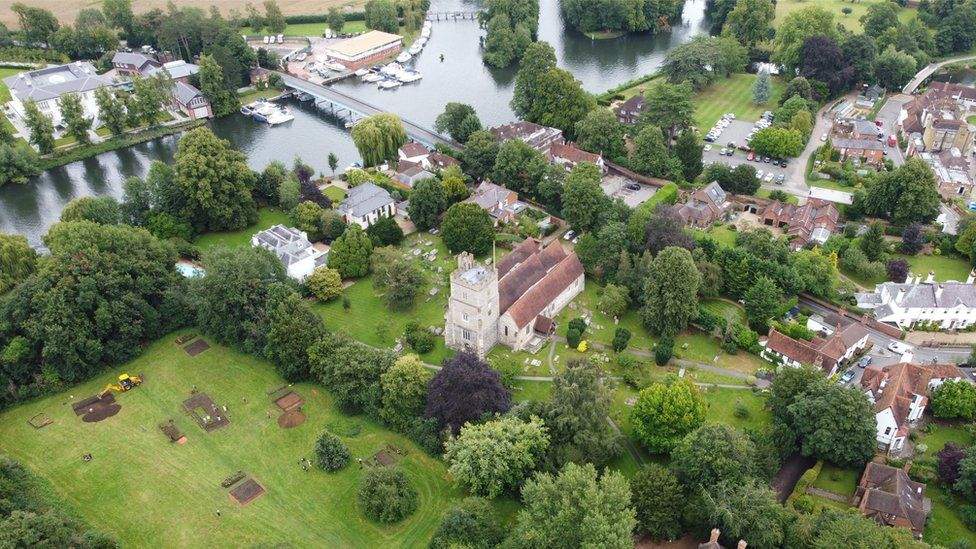In England, near the Berkshire town of Cookham on the outskirts of London, a team of archaeologists from theUniversity of Reading has discovered traces of an ancient 8th-century monastery. It is a site whose existence was known but whose location was unknown: it is the monastery of Queen Cynethryth, widow of the powerful King Offa of Mercia (who ruled over the region of England from 757 to 796), which has long been something of a puzzle for scholars. There were, in fact, written documents attesting that this monastery located along the banks of the Thames had as its abbess precisely Queen Cynethryth, but no evidence had ever been found that would allow scholars to know where it was actually located. Mercia, corresponding roughly to today’s central England, was one of the seven Anglo-Saxon kingdoms (the others were East Anglia, Northumbria, Wessex, Essex, Sussex and Kent), which in the 10th century eventually gave rise to the kingdom of England.
The excavation, conducted in the grounds of Holy Trinity Church in Cookham (one of the places for which the hypothesis had been made that it was the site of the monastery), thus led to the discovery, described as “revolutionary” in a note from the University of Reading. Remains of wooden buildings (those that housed the inhabitants of the monastery) were found as well as objects that offer various insights into their lives. “The lost monastery of Cookham,” said Gabor Thomas, archaeologist at the University of Reading, “has puzzled historians, and several theories had been put forward about its location. We decided to solve this mystery once and for all: the evidence we found confirms without a doubt that the Anglo-Saxon monastery was located on a gravel island beside the River Thames now occupied by the present parish church.”
“Despite its documented ties to the kings of Mercia,” Thomas added, “almost nothing is known about what life was like in this monastery, or other similar complexes on this stretch of the Thames, because of the lack of archaeological evidence. The objects that have been discovered will allow us to have a detailed reconstruction of how the monks and nuns who lived here ate, worked and dressed. This will shed new light on how Anglo-Saxon monasteries were organized and what life was like inside them.”
In ancient Mercia, along the banks of the Thames, there was in fact a network of monasteries built along what was one of the most important trade arteries in Anglo-Saxon England, which enabled these sites to become powerful and wealthy economic centers. The stretch of the Thames where today’s Cookham is located constituted a disputed border between the kingdoms of Mercia and Wessex, so the monastery here was of particular strategic and political importance.
Despite this historical context, the exact location of the monastery, as mentioned, has long been debated. And the excavation sought to answer that question by investigating the spaces near the churchyard of Holy Trinity Church. The University of Reading team uncovered a wealth of evidence including food remains, pottery vessels used for cooking and eating, and personal accessories including a delicate bronze bracelet and brooch, probably worn by female members of the community. Clear evidence has emerged of the structure of the monastery, which was organized into a series of delimited functional zones. One of these zones appears to have been used for housing and another for manufacturing, indicated by a set of hearths probably used for metalworking.
“Cynetryth,” said Thomas again, “is a fascinating figure, a female leader who clearly had significant status and influence during her lifetime. Not only were coins minted with her image, but it is well known that when Charlemagne wrote to his English counterparts, he wrote jointly to both King Offa and Queen Cynethryth, giving them both the same status. We are excited to find physical evidence of the monastery he presided over, which is also very likely to be his final resting place.” Cynethryth joined a religious order and became the royal abbess of the monastery after the death of her husband, King Offa, in 796 CE: before his departure she had ruled Mercia. King Offa is considered by many historians to be the most powerful Anglo-Saxon king before Alfred the Great. He is known for ordering the creation of the great rampart on the border between England and Wales, known as Offa’s Wall, which can still be seen today. Cynethryth is also the only Anglo-Saxon queen known to be depicted on a coin, a rarity anywhere in Western Europe during the period. She died sometime after 798 AD.
Pictured: the site of Queen Cynethryth’s monastery (excavation is bottom left).
 |
| England, traces found of lost monastery of Queen Cynethryth of Mercia |
Warning: the translation into English of the original Italian article was created using automatic tools. We undertake to review all articles, but we do not guarantee the total absence of inaccuracies in the translation due to the program. You can find the original by clicking on the ITA button. If you find any mistake,please contact us.